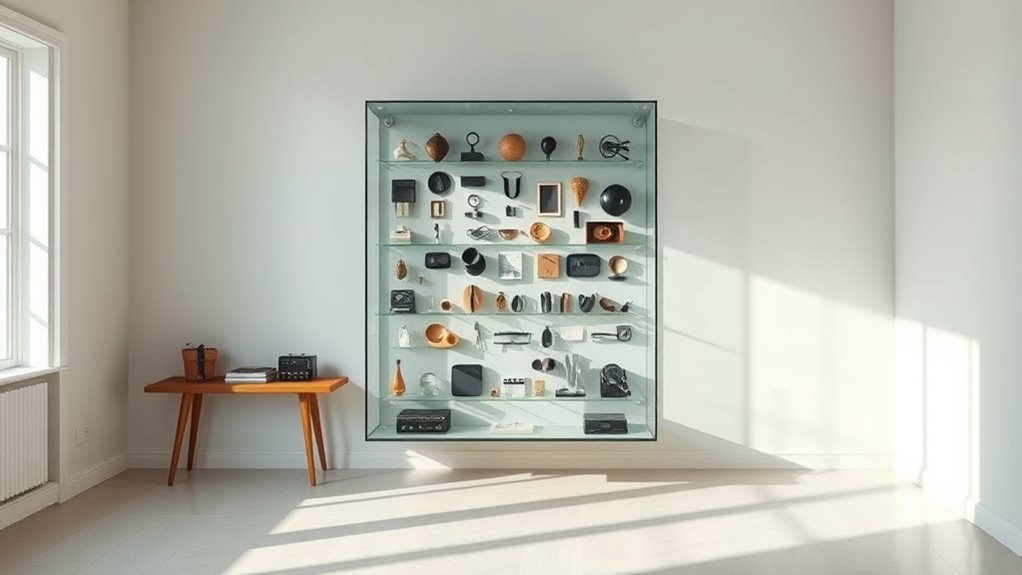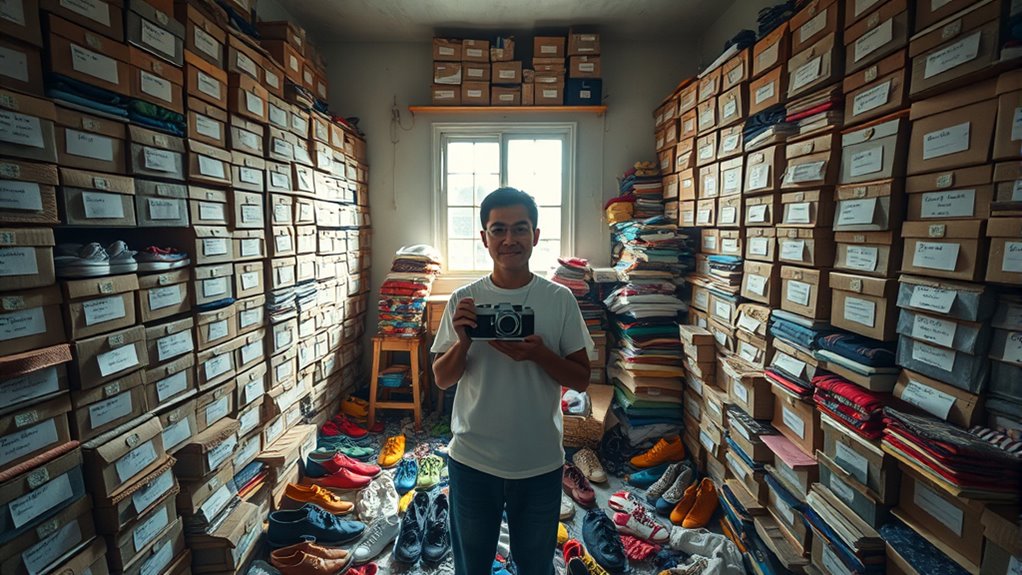Living with only 100 items challenges you to focus on what truly matters and embrace a minimalist mindset. You’ll need to confront emotional attachments, make intentional choices, and let go of excess possessions. It tests your resolve and patience but can bring mental clarity and a more meaningful daily routine. If you want to explore practical strategies and see how others have succeeded, keep going to find out more about how to make this lifestyle work for you.
Key Takeaways
- Achieving a 100-item lifestyle requires intentional decluttering and confronting emotional attachments to possessions.
- It promotes mental clarity, simplicity, and a focus on what truly matters in daily life.
- Small, manageable goals and gradual progress help build confidence in adopting minimalism.
- Letting go of excess possessions can be liberating and lead to greater personal freedom.
- Success depends on mindset, patience, and aligning possessions with core values and priorities.

Have you ever wondered if you really need all the possessions cluttering your life? The idea of living with just 100 items might seem extreme, but it’s rooted in the concept of minimalist living—a lifestyle focused on simplicity and intentionality. For many, the thought of decluttering challenges their comfort zone, forcing them to confront what truly matters and what’s just taking up space. The first step in this journey is understanding how freeing it can be to let go of excess. When you strip your possessions down to a core few, you may find that your mind clears, your priorities sharpen, and your daily routines become less chaotic. But the process isn’t without its hurdles; decluttering challenges often test your patience and resolve.
Initially, you might feel overwhelmed by the sheer volume of belongings you’ve accumulated. Sorting through years of stuff can seem intimidating, especially when emotional attachments or memories are tied to certain objects. You ask yourself, “Do I really need this?” and face the difficult task of making decisions. It’s easy to fall into the trap of holding onto items out of guilt or fear of regret. That’s why minimalist living requires a strong mindset—you have to be willing to confront your attachment to possessions and accept that letting go can be liberating. As you start decluttering, you’ll notice that the challenge isn’t just about physical space but also about mental clutter. Removing clutter creates room for clarity and purpose.
Overcoming emotional attachments is key to decluttering and embracing a minimalist, purposeful life.
Achieving a minimalist lifestyle often involves embracing intentionality—making deliberate choices about what to keep and what to let go. The key is to set small, achievable goals. Instead of aiming to reduce everything at once, focus on a single drawer, shelf, or category. Over time, these tiny victories add up, building momentum that makes the process less intimidating. You may discover that some items you thought were essential are actually unnecessary. This realization can be eye-opening and motivate you to continue. The journey toward a minimalist lifestyle isn’t about deprivation; it’s about making intentional choices that align with your values. As you shed possessions, you’ll likely find that your daily life becomes simpler and more meaningful. You won’t miss the clutter once it’s gone; instead, you’ll appreciate the space and mental clarity that come with it.
Ultimately, whether you can embrace living with just 100 items depends on your willingness to challenge your habits and face decluttering challenges head-on. It’s a process that pushes you beyond comfort zones, but many find it profoundly rewarding. With patience and a clear purpose, you can transform your relationship with possessions and discover the freedom that comes with a simpler, more intentional life.
Frequently Asked Questions
How Do I Decide Which Items to Keep or Discard?
When deciding which items to keep or discard, start with a clutter assessment to see what truly adds value to your life. Use item categorization to group similar belongings, making it easier to evaluate their importance. Ask yourself if each item serves a purpose, sparks joy, or is necessary. If not, it’s time to let it go. This process helps you create a more organized, intentional space.
What Are the Emotional Challenges of Downsizing to 100 Items?
Like peeling back layers of a cherished photo album, downsizing stirs emotional attachment, making each item a tether to memories. You might feel decision fatigue, as choosing only 100 items feels like a formidable puzzle. Letting go can evoke sadness or guilt, but remember, this process is about reclaiming space and clarity. Embrace the journey, knowing that your emotional strength will help you navigate these heartfelt choices.
Can This Lifestyle Work for Families or Only Individuals?
You can absolutely make this lifestyle work for families, as long as you consider family dynamics and prioritize adaptability. It requires everyone’s cooperation and understanding, but downsizing can foster closer bonds and simplify daily routines. With careful planning, you’ll find that reducing possessions helps everyone focus on what truly matters, creating a more intentional and manageable lifestyle for the whole family. Flexibility and communication are key to success.
How Do I Handle Sentimental Items I Want to Keep?
Imagine your sentimental items as silent guardians of your memories. To handle emotional attachment, prioritize sentimental preservation by choosing a few meaningful pieces rather than keeping everything. Create a dedicated space for these treasures, like a memory box or album, to honor their significance without clutter. This way, you respect your emotional attachment while maintaining a manageable, clutter-free environment that celebrates your history.
What Are Practical Tips for Maintaining Minimalism Long-Term?
To maintain minimalism long-term, you need practical strategies. Use effective storage solutions to keep clutter out of sight and maintain organization. Regular digital decluttering helps prevent digital chaos from accumulating. Set aside time monthly to review your belongings and digital files, ensuring only what truly matters stays. Embrace mindful consumption by questioning whether new items are necessary before bringing them in. Consistency is key to sustaining a minimalist lifestyle effortlessly.
Conclusion
Embracing the 100-item life might seem intimidating, but it’s about reclaiming your space and clarity. Did you know the average person owns over 300,000 items? Cutting down to just 100 can free you from clutter and stress. By simplifying your belongings, you create room for what truly matters. It’s not about perfection but intentional living. So, why not start today? Your simpler, more focused life awaits just beyond the clutter.









